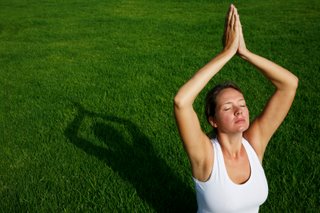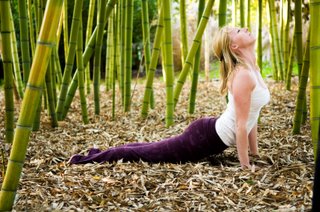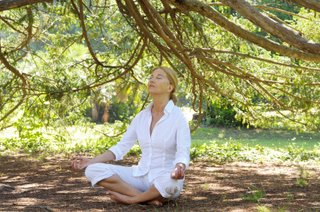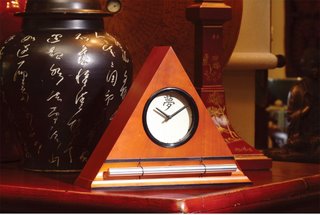|
 Secure Site
Secure Site
|
 |
Archive for the 'intention' Category
 Outdoor Yoga That most familiar of asana sequences, Surya Namaskar (Sun Salutation) is as rich in symbolic and mythic overtones as it is in physical benefits.
In many cultures, light has long been a symbol of consciousness and self-illumination. “The world begins with the coming of light,” wrote Jungian analyst Erich Neumann in The Origins and History of Consciousness (Princeton University Press, 1995). “Opposition between light and darkness has informed the spiritual world of all peoples and molded it into shape.”
Our primary source of light is, of course, the sun. When we look at our closest star, we may see nothing more than a big yellow ball. But for thousands of years, the Hindus have revered the sun, which they call Surya, as both the physical and spiritual heart of our world and the creator of all life itself. That’s why one of Surya’s many other appellations is Savitri (the Vivifier), who, according to the Rig Veda, “begets and feeds mankind in various manners” (III.55.19). Moreover, since everything that exists originates from the sun, as Alain DaniŽlou wrote in The Myths and Gods of India (Inner Traditions, 1991), it “must contain the potentiality of all that is to be known.” For the Hindus, the sun is the “eye of the world” (loka chakshus), seeing and uniting all selves in itself, an image of and a pathway to the divine.
One of the means of honoring the sun is through the dynamic asana sequence Surya Namaskar (better known as Sun Salutation). The Sanskrit word namaskar stems from namas, which means “to bow to” or “to adore.” (The familiar phrase we use to close our yoga classes, namaste—te means “you”—also comes from this root.) Each Sun Salutation begins and ends with the joined-hands mudra (gesture) touched to the heart. This placement is no accident; only the heart can know the truth.
The ancient yogis taught that each of us replicates the world at large, embodying “rivers, seas, mountains, fields…stars and planets…the sun and moon” (Shiva Samhita, II.1-3). The outer sun, they asserted, is in reality a token of our own “inner sun,” which corresponds to our subtle, or spiritual, heart. Here is the seat of consciousness and higher wisdom (jnana) and, in some traditions, the domicile of the embodied self (jivatman).
It might seem strange to us that the yogis place the seat of wisdom in the heart, which we typically associate with our emotions, and not the brain. But in yoga, the brain is actually symbolized by the moon, which reflects the sun’s light but generates none of its own. This kind of knowledge is worthwhile for dealing with mundane affairs, and is even necessary to a certain extent for the lower stages of spiritual practice. But in the end, the brain is inherently limited in what it can know and is prone to what Patanjali calls misconception (viparyaya) or false knowledge of the self.
The eight basic postures, in order of performance, are Tadasana (Mountain Pose), Urdhva Hastasana (Upward Salute), Uttanasana (Standing Forward Bend), Lunge, Plank Pose, Chaturanga Dandasana (Four-Limbed Staff Pose), Urdhva Mukha Svanasana (Upward-Facing Dog Pose), and Adho Mukha Svanasana (Downward-Facing Dog Pose).
The transition from posture to posture is facilitated by either an inhalation or an exhalation. As you move through the sequence, watch your breath closely. Slow your pace or stop and rest entirely if your breathing becomes labored or shuts down altogether. Always breathe through your nose, not your mouth: Nasal breathing filters and warms incoming air and slows your breathing down, thereby lending the sequence a meditative quality and reducing the risk of hyperventilation.
To perform the sequence, start in Tadasana, with your hands together at your heart. Inhale and lift your arms overhead to Urdhva Hastasana, then exhale while lowering the arms down and fold your torso into Uttanasana. Then inhale, arch your torso into a slight backbend with the fingertips or palms pressed to the floor or blocks, and exhale while bringing your left foot back into a lunge. Inhale forward to Plank, then exhale and lower yourself into Chaturanga Dandasana. On an inhalation, arch your torso up as you straighten your arms into Upward Dog. Exhale back to Downward Dog; step the left foot forward on an inhalation into Lunge. Swing the right leg forward to Uttanasana on an exhalation, then lift your torso and reach your arms overhead on an inhalation to Urdhva Hastasana. Finally, lower your arms on an exhalation and return to your starting point, Tadasana.
Remember, this is only a half-round; you’ll need to repeat the sequence, switching left to right and right to left to complete a full round. If you’re just starting out, it might help to work on the poses individually before you put them together. (Visit www.YogaJournal.com for more how-to information.)
adapted from Yoga Journal, by Richard Rosen
Use our unique “Zen Clock” which functions as a Yoga Timer. It features a long-resonating acoustic chime that brings your meditation or yoga session to a gradual close, preserving the environment of stillness while also acting as an effective time signal. Our Yoga Timer & Clock can be programmed to chime at the end of the meditation or yoga session or periodically throughout the session as a kind of sonic yantra. The beauty and functionality of the Zen Clock/Timer makes it a meditation tool that can actually help you “make time” for meditation in your life. Bring yourself back to balance.
 Yoga timers from Boulder, Colorado Now & Zen – The Yoga Timer Store
1638 Pearl Street
Boulder, CO 80302
(800) 779-6383
Posted in intention, Now & Zen Alarm Clocks, wake up alarm clock, Well-being, yoga, Yoga Timer, Yoga Timers by Now & Zen
 better posture from yoga Your mom was right: You’ll look better and feel great if you stop slouching and stand up straight. Yoga can help you do just that—in a way that honors your spine’s natural curves. Here’s a guide to assessing and improving your posture.
Are you a slumper? A swayer? Chances are you’re one or the other to some degree—despite Mom’s best efforts all those years ago to get you to sit up straight and stop slouching. She probably told you that you’d look and feel better if you worked on your posture, and she was absolutely right. But if you’re like most people, you rolled your eyes and ignored her, or straightened up until she wasn’t looking. And you probably didn’t give posture much more thought at all until you walked into your first yoga class and tried to stand in Tadasana (Mountain Pose).
When you’re a beginner, it’s surprisingly complicated to master the art of rooting down through the feet while lengthening up through the spine, keeping your chest open without jutting your lower ribs out, and keeping the legs muscles strong and lifted without tensing the belly or jaw. But ultimately, Tadasana demands just one simple thing: that you stand in a way that supports the natural curves of a healthy spine. So why is it so difficult? And why do we work so hard to master good posture in yoga—leaving class feeling taller and healthier—only to slump down in the car seat on the way home or revert to a swayback when we heft our overstuffed yoga bags onto our backs?
In short, modern life conspires against good posture. We spend our days sitting at desks, staring at computer screens. When we travel, we do it in cars or—worse—airplanes. We lounge around in overstuffed chairs designed more for looks than for lumbar support. And we pay people to mow our lawns, tend our gardens, and remove our trash so we can spend more time working or driving or sitting. Nonsedentary cultures—with a few exceptions—don’t have the same epidemic of back and neck problems that we do. Picture a woman gracefully balancing a large basket of food on her head. To carry such a heavy weight, she must have a perfectly aligned spine and strong posture-support muscles. You don’t get that kind of alignment and strength from sitting around and watching the tube. You can, however, get it from a regular yoga practice.
Take comfort in knowing that yoga trains your mind as well as your body. As you continue to devote yourself to your practice, you will become more present in your body and more aware of your alignment, and you will begin to naturally make choices that will improve your health and your quality of life. Over time, the combination of increased awareness and physical training will allow your improved alignment to spill out into other areas of your life. Before you know it, you’ll feel at ease as you practice good yoga alignment while you’re perched at your desk, standing at the copier, and sitting at dinner. You’ll be doing yoga during all of your waking hours. And who knows? You might just impress your mom!
adapted fromYoga Journal, by Julie Gudmestad
Use our unique “Zen Clock” which functions as a Yoga Timer. It features a long-resonating acoustic chime that brings your meditation or yoga session to a gradual close, preserving the environment of stillness while also acting as an effective time signal. Our Yoga Timer & Clock can be programmed to chime at the end of the meditation or yoga session or periodically throughout the session as a kind of sonic yantra. The beauty and functionality of the Zen Clock/Timer makes it a meditation tool that can actually help you “make time” for meditation in your life. Bring yourself back to balance.
 Zen Timepiece, a yoga timer and clock with Tibetan bowl Now & Zen – The Yoga & Meditation Timer Store
1638 Pearl Street
Boulder, CO 80302
(800) 779-6383
Posted in intention, Well-being, yoga, Yoga Timer, Yoga Timers by Now & Zen, Zen Timers
 Kid Yoga Lotus Pose When presented in a child’s language, yoga can help counter the stress experienced by young people living in a hurry-up world.
Our children live in a hurry-up world of busy parents, school pressures, incessant lessons, video games, malls, and competitive sports. We usually don’t think of these influences as stressful for our kids, but often they are. The bustling pace of our children’s lives can have a profound effect on their innate joy—and usually not for the better.
I have found that yoga can help counter these pressures. When children learn techniques for self-health, relaxation, and inner fulfillment, they can navigate life’s challenges with a little more ease. Yoga at an early age encourages self-esteem and body awareness with a physical activity that’s noncompetitive. Fostering cooperation and compassion—instead of opposition—is a great gift to give our children.
Children derive enormous benefits from yoga. Physically, it enhances their flexibility, strength, coordination, and body awareness. In addition, their concentration and sense of calmness and relaxation improves. Doing yoga, children exercise, play, connect more deeply with the inner self, and develop an intimate relationship with the natural world that surrounds them. Yoga brings that marvelous inner light that all children have to the surface.
When yogis developed the asanas many thousands of years ago, they still lived close to the natural world and used animals and plants for inspiration—the sting of a scorpion, the grace of a swan, the grounded stature of a tree. When children imitate the movements and sounds of nature, they have a chance to get inside another being and imagine taking on its qualities. When they assume the pose of the lion (Simhasana) for example, they experience not only the power and behavior of the lion, but also their own sense of power: when to be aggressive, when to retreat. The physical movements introduce kids to yoga’s true meaning: union, expression, and honor for oneself and one’s part in the delicate web of life.
adapted from Yoga Journal, by Marsha Wenig
Use our unique “Zen Clock” which functions as a Yoga Timer. It features a long-resonating acoustic chime that brings your meditation or yoga session to a gradual close, preserving the environment of stillness while also acting as an effective time signal. Our Yoga Timer & Clock can be programmed to chime at the end of the meditation or yoga session or periodically throughout the session as a kind of sonic yantra. The beauty and functionality of the Zen Clock/Timer makes it a meditation tool that can actually help you “make time” for meditation in your life. Bring yourself back to balance.
 Yoga timers and gentle wake up clocks with chimes Now & Zen – The Yoga Timer Store
1638 Pearl Street
Boulder, CO 80302
(800) 779-6383
Posted in intention
 Kids yoga There’s never a dull—or quiet—moment in Kate Roades’s yoga classes for kids. “Oh, it’s never silent,” she says, adding that chatting, laughter, and audible groans are the norm. Just recently a little student quipped midpose, “I am not a cobra, Teacher Kate, I am a seal.” Roades’s enthusiasm and accepting attitude during moments like these make her a great teacher—giggling is OK in her classes, as is saying a pose feels funny. She’s learned plenty of tricks teaching at It’s Yoga Kids, the San Francisco studio she opened with partner Michelle Wing in early 2006.
How can parents who want to practice with their kids follow her lead? First, says Roades, know that your child might not be hooked right away. Like adults, kids want to be good at things, and yoga can seem strange at first. “By the third time it’s usually not so foreign,” Roades says. She also encourages incorporating positions that your child already knows (like sitting cross-legged) into each session to build confidence. Once they are in a pose, tell them how many breaths they will stay in it, to help them feel safe. Finally, limit practices to 30 minutes or less and use language they’ll enjoy and understand.
Most of all, says Roades, make it fun, and your children will begin to feel stronger and calmer in their daily life. “Giving children the tools to feel confident is priceless,” Roades says. “Teaching kids how to relax and deal with their emotions is incredible.”
adapted from Yoga Jounal
Use our unique “Zen Clock” which functions as a Yoga Timer. It features a long-resonating acoustic chime that brings your meditation or yoga session to a gradual close, preserving the environment of stillness while also acting as an effective time signal. Our Yoga Timer & Clock can be programmed to chime at the end of the meditation or yoga session or periodically throughout the session as a kind of sonic yantra. The beauty and functionality of the Zen Clock/Timer makes it a meditation tool that can actually help you “make time” for meditation in your life. Bring yourself back to balance.
 Bamboo Yoga Timer for Kids Now & Zen – The Yoga Timer Store
1638 Pearl Street
Boulder, CO 80302
(800) 779-6383
Posted in intention, mindfulness practice, yoga, Yoga Timer, Yoga Timers by Now & Zen
 meditation under tree A good example of body-mind-body medicine is the work of Jon Kabat-Zinn, Ph.D., founder of the Stress Reduction Clinic at the University of Massachusetts Medical School and author of the bestsellers Full Catastrophe Living and Wherever You Go, There You Are. His Mindfulness-Based Stress Reduction (MBSR) approach, which combines gentle hatha yoga with mindfulness meditation, has garnered impressive results in scientific studies and is now taught at hundreds of hospitals and clinics worldwide.
In his work with patients with a wide variety of medical conditions, including chronic pain, cancer, arthritis, anxiety, and depression, Kabat-Zinn has observed that particular patients seem to respond better to some elements of the MBSR program. He has found that those with primarily physical complaints, such as joint pain, often do best when they use meditation to go through what he calls the “mind door.” Others, particularly those with mental problems such as anxiety or panic attacks, may do better with “body door” approaches like asana.
adapted from Yoga Journal by Timothy McCall, M.D.
Use our unique “Zen Clock” which functions as a Yoga Timer. It features a long-resonating acoustic chime that brings your meditation or yoga session to a gradual close, preserving the environment of stillness while also acting as an effective time signal. Our Yoga Timer & Clock can be programmed to chime at the end of the meditation or yoga session or periodically throughout the session as a kind of sonic yantra. The beauty and functionality of the Zen Clock/Timer makes it a meditation tool that can actually help you “make time” for meditation in your life. Bring yourself back to balance.
 Gentle wake up alarm clock by Now & Zen Now & Zen – The Zen Alarm Clock & Timer Store
1638 Pearl Street
Boulder, CO 80302
(800) 779-6383
Posted in Chime Alarm Clocks, intention, Meditation Timers, Meditation Tools, mindfulness practice, Natural Awakening, Now & Zen Alarm Clocks, wake up alarm clock, yoga, Yoga Timer
 ume tree (japanese blum) Kaisan-do of Ryodaishi temple Train yourself to reflect before you buy something. Why do you want it? Do you really need it, or are you trying to escape negative emotions? Yoga can help you do without retail therapy, Main says: “The word asana means ‘sit’ … Yoga teaches us to sit with uncomfortable physical sensations, to breathe and relax into them. So when a negative emotion arises, instead of trying to bury it under a new pair of shoes or an iPod or whatever, let it bubble to the surface, look at it, and let it go.” Davis says her yoga practice of 14 years helps her stick to the Compact. “Yoga makes you deal with what’s really going on inside, instead of medicating it through shopping.”
Luhrs says she loves clothes but not as much as she loves the freedom of being debt free. In order to avoid running up credit card bills, she asks herself five questions before buying anything: “Do I have the cash to pay for it? Do I have room in my closet for this outfit? Do I want another outfit? Do I want to care for more clothes? Will I really wear this item a lot? ” You can run through a similar checklist of questions whenever you’re considering buying something new. If it’s an item for the home, Luhrs suggests, “Ask yourself if your eyes need one more thing to look at, or would they rather rest in open space?”
Of course, after reflection, you may decide that you genuinely need something. Before you buy it new, consider alternatives. Can you mend yours? Can you borrow it? Can you buy it used? The obvious places to look for secondhand stuff are thrift stores, garage sales, and secondhand furniture stores. But you can also try craigslist or Freecycle, a network of local groups whose members give each other unwanted items. In San Francisco, Compacters use Building REsources for salvaged architectural material like windows and doorknobs, and SCRAP (Scroungers’ Center for Reusable Art Parts) for low-cost fabric and art supplies. You may be able to find similar resources in your area.
adapted from Yoga Journal, by Helena Echlin
 Maple Leaves Dial Face, Zen Alarm Clock with Maple Finish Now & Zen
1638 Pearl Street
Boulder, CO 80302
(800) 779-6383
Posted in intention, wake up alarm clock, Well-being, yoga, Zen Timers
 Happiness Most people on a spiritual path eventually recognize that happiness can’t be bought. To find the peace we truly seek, it’s necessary to stop mindlessly acquiring possessions—and embrace simplicity. How, exactly, do you do that? The first step is to figure out why you want to simplify. Bruce Elkin, the author of Simplicity and Success and a life coach who helps clients simplify, distinguishes between “reactive” and “purposeful” simplicity. “If you clean out clutter to declutter, it’s a temporary fix,” he says. “But if you clean out the clutter to make a meditation space or a reading area, then you have a clear purpose. The clutter doesn’t return.
Andrews compares simplifying to dieting. Self-denial will backfire. “Don’t say to yourself, ‘I’m not going to have this or that.’ Instead of focusing on what you’re denying yourself, focus on what’s really healthy or, in this case, on whatever gives you true satisfaction. ”
Leventhal is focused on what he has gained: time to volunteer for community service and time with his partner and dogs. Davis doesn’t miss shopping either. She’s too busy concentrating on her essentials: “writing, reading, dreaming, socializing, music, dance, sunshine, exercise, cooking.” She also makes movies in her spare time. And Lyon doesn ‘t pine for a nice car or fashionable clothes, because her modest lifestyle allows her to pursue her passions: teaching yoga and working toward an M.A. in psychology.
 Gentle Wake Up Clocks with Chimes Now & Zen
1638 Pearl Street
Boulder, CO 80302
(800) 779-6383
Posted in intention
 When less is more Make more time for doing the things you love by simplifying your life.
Judy Davis never buys anything new if she can help it. A 58-year-old freelance marketing consultant who lives in Red Bluff, California, she favors thrift store clothing and secondhand furniture. Instead of buying gifts, she gives plants from her garden or bags she has sewn from cut-up vintage gowns. Judy is part of a Bay Area group called the Compact. The Compacters have vowed not to buy anything new for a year except bare essentials: food, medicine, cleaning products, and underwear (although not, of course, lingerie from Paris). Although few people take frugality quite as seriously as the Compacters do, more and more of us are voluntarily cutting back on buying and consumption. Many individuals choosing this lifestyle happen to be yogis. The seminal work of yoga philosophy, Patanjali’s Yoga Sutra, frowns on materialism, and some yogis find that their asana practice alone helps them be happier with less.
The pursuit of the simple life is nothing new, of course. From Quakers to Transcendentalists, America has always had its share of those who associate simplicity with spiritual growth. Back-to-the-land hippies of the ’60s and ’70s found simplicity appealing for more secular reasons, such as ecological sustainability. But those who practice pared-down living today are not necessarily spiritual ascetics or off-the-grid granola types. Most are ordinary people modifying their everyday behavior-trying to be conscious about what they eat, drive, and buy.
In the past 15 years, “voluntary simplicity,” as it is called, has gained thousands of converts. Many books on the subject have been published, such as Janet Luhrs’s The Simple Living Guide, Cecile Andrews’s Circle of Simplicity: Return to the Good Life, and Linda Breen Pierce’s Choosing Simplicity: Real People Finding Peace and Fulfillment in a Complex World. Dozens of websites have sprung up, and nonprofits like Seeds of Simplicity and Simple Living America champion the cause. When the Compacters publicized their manifesto in January 2006, their Yahoo group swelled from about 50 in February to 1,225 in July, with members across America.
Most spiritual traditions encourage simple living, and yoga is no exception. In the Yoga Sutra, Patanjali laid out the yamas (moral restraints) and niyamas (observances), a set of 10 principles that are crucial to one’s progress along the yogic path. One of the yamas is aparigraha, often translated as “greedlessness.” But it means more than just taking only what you need, explains David Frawley, founder and director of the American Institute of Vedic Studies and author of Yoga and the Sacred Fire. Aparigraha also means “not having a lot of unnecessary things around yourself and not hankering after what other people have,” Frawley says. In other words, aparigraha also means keeping only what you need and wanting only what you need.
Aparigraha leads naturally to one of the niyamas: santosha, or “contentment,” being satisfied with the resources at hand and not desiring more. Ultimately, Frawley says, “Yoga is about transcending the desire for external things, which is the cause of suffering, and finding peace and happiness within.”
adapted from Yoga Journal, by Helena Echlin
 Zen Alarm Clocks Now & Zen
1638 Pearl Street
Boulder, CO 80302
(800) 779-6383
Posted in intention, Meditation Timers, Meditation Tools, mindfulness practice, Now & Zen Alarm Clocks, Well-being, zen, Zen Alarm Clock, Zen Timers
 how to say no You caved — again. Now you’re stuck chairing the annual fund-raiser (or cat-sitting for your neighbor, or working late). What if you could turn down that request, that offer, that invite, and not feel so guilty about it afterward? Wouldn’t it be great if once, just once, you could stick to your guns and say no when you needed to most?
There are lots of reasons we struggle with “no.” Some feel bound by obligation or by fear of hurting someone’s feelings. Others believe they really can do it all (and hate to pass up the opportunity to try). But think about it: Almost every misplaced yes is really a no to yourself.
“When you can’t say no,” says negotiator William Ury, Ph.D., author of “The Power of a Positive No,” “you give up what’s essential to you in favor of what other people want.” You also put yourself on a fast track to a meltdown. “When you take on more than you can handle, you eventually burn out,” says Nanette Gartrell, M.D., author of My Answer Is No … If That’s Okay with You. “It’s not uncommon to develop exhaustion or even depression as a result.”
By asserting yourself in a considerate, confident way, says Ury, you can be selective about what you take on without jeopardizing friendships — a people-pleaser’s biggest fear. Try our five-step plan so that you can start saying no — and stop feeling guilty.
Five Steps to Saying No
1. Find Your Yes
Before you can even think about getting good at saying no, get clear on what to say yes to in life. If your yes is more time with your family, that will mean turning down obligations that keep you away from home. If it’s yes to better health, you’ll need to say no to late nights at work that keep you from the gym. The firmer your foundation and connection to your yes, says Ury, the less difficult it will be to say no. After all, you’ll be answering to a higher cause.
2. Buy Some Time
Whenever possible, don’t respond to a request on the spot. This keeps you from saying yes under pressure (“Um … sure I’ll host the baby shower”) or reacting emotionally to the request, especially when you’re feeling stressed out. “We can’t say no without getting a firm grip on our natural reactions and emotions,” says Ury — and that won’t happen unless you’ve taken the time to collect your thoughts.
To gain some perspective, Ury suggests getting some distance from the issue at hand physically and mentally for a few hours, or even a day. Figure out whose interests are at stake, what’s really being asked of you, and whether it makes sense to say yes. But be sure not to wait too long; leave the person hanging indefinitely, and you could damage a relationship.
3. Deliver Your No with Grace and Resolve
The moment of truth can be the most difficult of all, particularly when you’re afraid of hurting someone’s feelings. Ury suggests a “yes-no-yes” approach: First, share what you’re currently saying yes to (“My mother and I always go out for breakfast on Saturday mornings”). Then say no (“So I won’t be able to help you set up for the brunch you’re hosting”).
But don’t stop there. After you’ve turned someone down, affirm your good intentions by closing with another yes — this time, to a mutually positive outcome (“But I’d be happy to help clean up after it’s over”). In so doing, you relieve some of the frustration wrought by closing a door, while sending the message that you respect the other person’s needs.
For greater requests of your time — say, to serve on the town board or help a colleague launch her new business — be direct and to the point: You’re flattered but have decided to devote any free time to your children’s school instead. Avoid burdening the other person with unnecessary or elaborate excuses (such as how your mother moved away and can’t watch the kids). You run the risk of the other person trying to fix the situation (“Bring the kids, then!”). Plus, the more drawn-out the excuse, the less authentic it sounds — and, in the end, it’s really no one else’s business.
4. Have a Plan B
Even if the other person gets emotional or reactive after you’ve delivered your no, don’t yield under pressure — as difficult as this may seem. Instead, take a deep breath and listen attentively to his or her objections. Then, gently but firmly, underscore your no — and keep it simple and clean; no backpedaling or scrambling for defense.
What if your no is met with extreme resistance? Your in-laws insist that you spend the holidays at their home again; a colleague plays hardball in pressuring you into taking over a project. For this, Ury proposes having a Plan B. Think about what’s at stake (your time, resources, or respect) and be ready to pursue another path if your original no goes unheeded.
If your no fails to convince a pushy coworker that you can’t take on extra projects, for instance, plan to bring the conversation to a close and go to your boss with your concerns if necessary. If your sister has a habit of dropping the kids off unannounced (despite your protests that you have other pressing obligations), decide that next time she ignores your no, you will respectfully tell her you already have plans — and then leave the house. “The key here is not necessarily to leap to Plan B,” says Ury, “but to have it in mind so that, going in, you know you have alternatives.”
Note that while Plan B works wonders when it comes to isolated situations, it can also be incredibly helpful in addressing general patterns you fall into. Your Achilles’ heel might be lending money to friends and family (and forgetting to get repaid) or going weak when the nonprofit solicitors come knocking. Recognize these tendencies, and you’ll be more effective in lining up your own backup plan.
5. Cut Yourself Some Slack
Even with practice, some will always find saying no a challenge. For the dyed-in-the-wool people pleaser, there may be a twinge of guilt — and, for the overly ambitious, regret. Realize that your perennial inclination to offer help is something to be lauded, not criticized. “Be proud of the qualities that make it so hard to say no — thoughtfulness, empathy, compassion, generosity,” says Gartrell. “Without them, the infrastructure of our society would collapse.” Just bear in mind that by balancing your “pleaser” and “doer” tendencies with a commitment to your values, you’ll be stronger for it. Even better, you’ll be a more focused contributor to the people and things that matter most to you.
How to Say No
There’s more than one way to say it. Skip the excuses and opt for one of these suggestions from author William Ury.
“Not now.” This softens the blow and keeps the door open for another time.
“I have another commitment.” No other excuse required; you honor your commitments.
“Maybe I can help you find someone who can.” This shows respect and concern.
“I have a personal policy about …” And fill in the blank. By saying this, you put the focus on a prior commitment to yourself without opening the door for an argument (useful, say, when someone wants you to commit to working on Saturdays or give to a charity when you have a different one in mind).
“I don’t want to take on what I can’t fully commit to doing well.” This is a yes to higher standards.
adapted from Body + Soul, March 2008
 - Bamboo Zen Clock
Now & Zen
1638 Pearl Street
Boulder, CO 80302
(800) 779-6383
Posted in Chime Alarm Clocks, intention, Meditation Tools, Natural Awakening
 Healing Gems In this relaxing ritual, you’ll gather stones to stimulate the body’s seven main energy centers, or chakras, in the Ayurvedic tradition. While many massage therapists use large stones to massage out tension in muscles, simply placing stones at strategic points on the body can encourage relaxation.
On a sunny day, take a stroll along the beach to gather seven dark-colored, smooth, round stones, preferably 1 or 2 inches in diameter. Set your Zen Timer to 15 minutes. Set them down in a sunny spot and allow them to warm up for 10 to 15 minutes. When you’re ready, lie flat on your back and place a stone on each of the seven chakras (see Vital Energy Centers), one by one. Let your body relax and sink into the ground; feel the weight of each stone and the sensation it creates on your skin. Visualize energy radiating from each chakra through your body, from the top of your head through your toes. Set your Zen Timer for 20 minutes. Relax for about 20 minutes, and then remove the stones.
adapted from Body + Soul, July/August 2006
 Zen Timers Now & Zen
1638 Pearl Street
Boulder, CO 80302
(800) 779-6383
Posted in intention, Meditation Timers, mindfulness practice, Now & Zen Alarm Clocks, Well-being, Zen Alarm Clock, Zen Timers
« Previous Page — « Previous Entries
Next Entries » — Next Page »
|
|
|
|